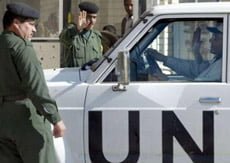On Oct. 15, Iraq’s Ministry of Science and Technology alerted the United Nations’s nuclear watchdog, the International Atomic Energy Agency (IAEA), to the disappearance of 377 tons of high explosives from the Al-Qaqaa storage facility, located south of Baghdad. According to Reuters, Iraqi officials said that the explosives went missing after the April 9, 2003 fall of Baghdad “through the theft and looting of governmental installations due to a lack of security.”
The lost explosives consist of 195 tons of high melting explosives (HMX) and 141 tons of cyclonite (RDX), the BBC reported. Both are major components in plastic explosives.
Defense Secretary Donald Rumsfeld said Oct. 29 that it was “very likely” that Saddam Hussein had moved the explosives long before the war.
“First reports are almost always wrong,” he said. “People who used hair-triggered judgment to come to conclusions about things that are fast moving frequently make mistakes that are awkward and embarrassing.”
On Oct 28, ABC News reported that a video shot by a crew from the ABC television affiliate KSTP of St. Paul, Minn., which was embedded with the 101st Airborne Division as it secured Al-Qaqaa April 18, 2003, shows barrels which have been identified by experts as containing the explosive HMX.
“I talked to a former inspector who’s a colleague of mind, and he confirmed that, indeed, these pictures look just like what he remembers seeing inside those bunkers,” David Albright, president of the Institute for Science and International Security in Washington, said.
“The seal’s critical,” he added. “The fact that there’s a photo of what looks like an IAEA seal means that what’s behind those doors is HMX. They only sealed bunkers that had HMX in them.”
A twist in the situation came when the Defense Department announced that U.S. soldiers led by Maj. Austin Pearson had removed explosives from the site in April 2003.
“I did not see any IAEA seals at locations we were looking into,” Pearson told reporters at a press conference at the Pentagon Oct. 29.
The IAEA last inspected the Al-Qaqaa facility in Jan. 2003, but has not be allowed back since the war began.
Both Democrats and Republicans addressed the missing explosives during the last weeks before Election Day.
Sen. John Kerry (D – Mass.) immediately used the information in an attempt to undermine President George W. Bush and the war in Iraq, The Washington Post reported.
“He’s doomed to make the same mistakes all over again,” Kerry said. “Three hundred and eighty tons of explosives that could be in the hands of terrorists, and he would do exactly the same?”
“No matter how you try to blame it on the president, the actual responsibility for it really would be for the troops that were there,” Republican Rudy Giuliani, former mayor of New York City, said on NBC’s Today Show Oct. 28. “Did they search carefully enough – didn’t they search carefully enough?”
John Edwards, Kerry’s running mate and former Democratic senator from North Carolina, responded at a rally Oct. 28 in Duluth, Minn. “Aren’t we sick and tired of George Bush and Dick Cheney using our troops as shields to protect their own jobs instead of doing everything they should to protect our troops?” he said, according to The Washington Post. “Our men and women in uniform did their job. George Bush didn’t do his job.”
Analysts at ABC News say the missing explosives could have found their way into the hands of insurgents, such as those under siege in Falluja.
The city has been a hotbed of insurgent activity since the invasion. In October, interim Prime Minister Iyad Allawi gave the insurgents an ultimatum to hand over the Jordanian-born rebel leader Abu Musab al-Zarqawi, whom he believed to be in the city.
Al-Zarqawi has claimed responsibility for the beheadings of U.S. engineers Eugene Armstrong and Jack Hensley and Briton Ken Bigley.
Beginning Nov. 5, U.S. forces began building up around Falluja, shelling suspected insurgent positions, and instituting a comprehensive siege, refusing nearly all traffic in or out of the city. Prior to Nov. 5, they had distributed leaflets and delivered broadcasts encouraging civilians to leave the city.
On the heels of the siege, Allawi declared a state of emergency in Iraq Nov. 7, instituting martial law for 60 days due to an escalation of militant attacks on Iraqi police forces and coalition forces.
The BBC has reported that only about 60,000 civilians out of a total civilian population of 300,000 are suspected to have remained in Falluja. The BBC’s embedded reporter Paul Wood, predicted that the attack on Falluja will be the U.S. Marines’s largest attack since Hue, the Vietnamese city captured in 1968.
CNN reported that approximately 10,000 U.S. soldiers and Marines and 2,000 troops from Iraq’s new army launched Operation New Dawn against 2,000 – 3,000 Iraqi insurgents Nov. 8.
“The enemy has got a face,” Lt. Col. Gareth Brandl, one of the batillion commanders spearheading the assault, said. “He’s called Satan. He lives in Falluja. And we’re going to destroy him.

